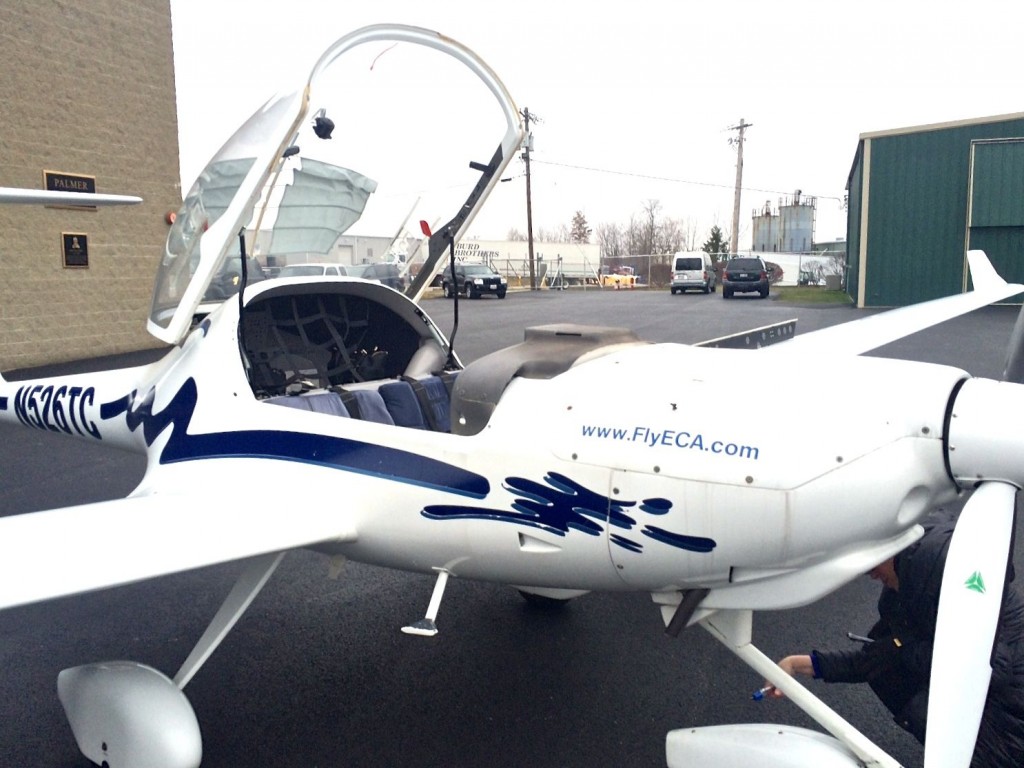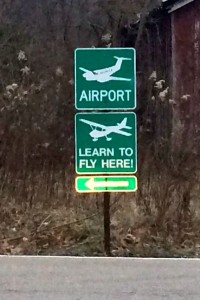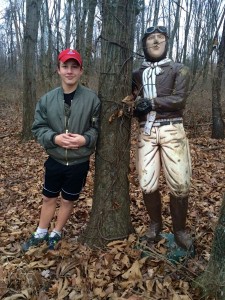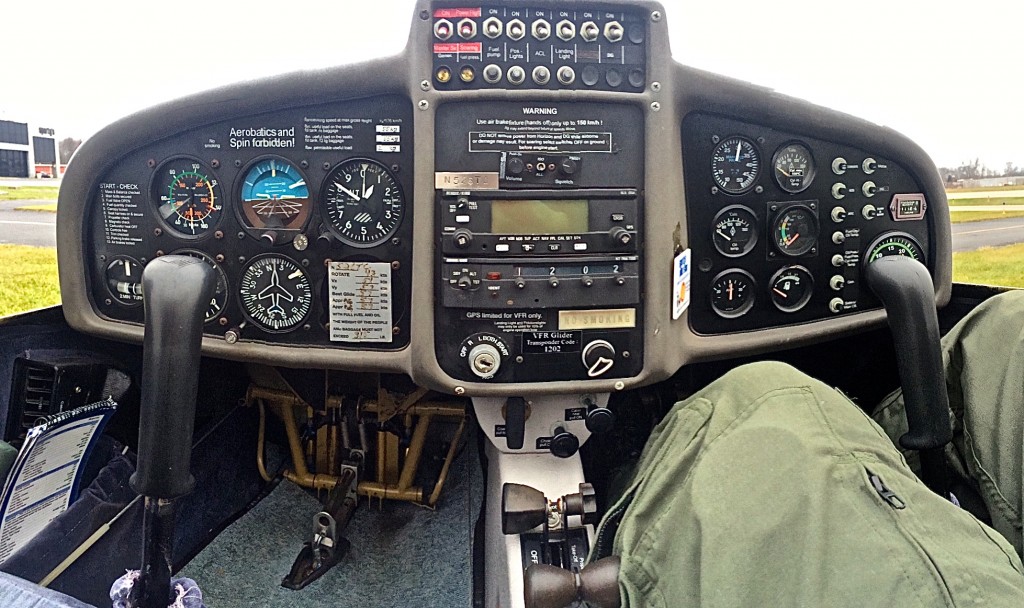Time for an update on pilot-y activities. As many of you know, I’ve been working on my instructor certificate in the glider category. I knocked out the FOI knowledge test in April and I finally got the CFI-G knowledge test done – appropriately enough – on Halloween afternoon. Then I contacted the FSDO about getting my checkride.
I’ll hand it to Larry McKillop at the Michigan East FSDO for doing the best that he can to try to get me a ride. And I’ll hand it to Kerry Brown, the DPE who did my commercial checkride, for being ready, willing, and able to administer the ride. But the whole process has been a sheep dip from the beginning. Without numbing your mind with the Byzantine ways of the FAA, I can’t seem to get a checkride in the Michigan East FSDO. Kerry is not an FEI and, even if the Michigan East FSDO wanted to designate him to do the ride, he’d have to be supervised. No one qualified to supervise the ride exists or has answered the call to supervise a ride. I reached out to a resource in the West Michigan FSDO who I understand could have done the ride, but that resource has declined to return phone calls.
Part of this is my fault. I’m looking for (a) a CFI checkride (b) that’s an initial CFI checkride (and there’s stan/eval magic about initial CFI rides) (c) in the glider category (d) in a self-launch glider (e) in the upper midwest (f) in the dead of winter. Yeah, that’s a little specialized. But it’s not like I invented a new category or like I’m asking someone to strap into an experimental spaceship.
So I’m sitting here nearly two months later with no chance of anything happening in either FSDO in Michigan. As I do so, all of the information that I’ve packed into my noggin is spilling out of my ears. I have this huge plastic tub of study materials, teaching aids, manuals, and other stuff that I need to have memorized or at the ready against an oral exam that is justly reputed to be the most savage exercise in all of general aviation. It’s nearly impossible to stay perpetually ready for the FAA CFI-G oral and the sooner I get the checkride done, the sooner I can have an evening during which I don’t have to sit in a Starbucks with a brick of 4×6 cards, murmuring to myself like a madman.
I heard that there’s a Diamond HK 36 TC (Diamond XTREME) at Sporty’s Academy at Clermont County Airport in Ohio and a DPE on staff there who’s eligible to do the ride. So I headed down to Sporty’s on Friday to see whether it would be an option to qualify in the Diamond and fly the ride in that bird.
And, besides, Sporty’s is legendary in the GA world and it seemed only proper to do a pilgrimage to that hallowed airport. So I sprung FOD from school early and we headed down. Sporty’s turned out to be everything they say it is and more. Just about everything that you can do right in general aviation, Sporty’s has done. The airport is located back in the boonies and would be difficult to find, except that signs pointing to the airport are everywhere.
As you make your way up Sporty’s Drive, pilot figures look out at you from the woods. FOD noticed them before I did. I can’t decide whether they’s cool or creepy. So I took a shot of FOD next to one. I hope that they’re not memorials to pilots who have gone west or anything such that taking the picture was an act of disrespect.
There’s a huge area with cafe seating and a vending area and that seems to be where most of the briefing and debriefing takes place. Some of the tables are specially designated, such as the one reserved for liars, which I presume any pilot could occupy with little fear of ineligibility.
A quick note to those who have formed expectations about this mecca of pilot gear and other merchandise. One might be forgiven for expecting that the pilot shop at the airport is 100,000 sq. ft. of gadgets and T-shirts. It’s not. Or at least it’s not all retail. The shop itself is something like 200 sq. ft. of stuff in cases. But you can go to the desk and point to anything you like from the Sporty’s catalog and someone will be dispatched to the warehouse (sometimes on a bicycle) to fetch what you want. I sent FOD to get me an el cheapo device to strap my new iPad to my leg and he returned with tidings of the bicycle logistics.
Shortly after arriving, I met up with Charissa A. Dyer-Kendler, my instructor for the day. She’s a CFI, CFII, CFI-G, and AGI with a Gold Seal designation and a Ph.D. to boot. We preflighted the Diamond, started up, and taxied out.
The Diamond is a two-place motorglider. The numbers (as reported by the Wikipedia entry, are as follows.
General characteristics
Crew: one
Capacity: one passenger
Wingspan: 16.0 m (52 ft 6 in)
Wing area: 15.24 m2 (164.0 sq ft)
Aspect ratio: 16.8:1
Airfoil: Wortmann FX 63-137
Empty weight: 497 kg (1,096 lb)
Gross weight: 770 kg (1,698 lb)
Fuel capacity: 80 liters (18 imp gal; 21 US gal)
Propellers: One 2-bladed Hoffmann HO-V 62-R/L 160 T, three position, fully feathering.
Performance
Cruise speed: 182 km/h; 98 kn (113 mph)
Never exceed speed: 275 km/h (171 mph; 148 kn) sea level to 6000 feet
Range: 1,094 km; 591 nmi (680 mi)
Maximum glide ratio: 27:1 at 105 km/h (65 mph)
Rate of sink: 0.91 m/s (179 ft/min) at 79 km/h (49 mph)
Wing loading: 48.56 kg/m2 (9.95 lb/sq ft)
The weather was somewhere between 1,500 and 3,000 overcast with nearly calm winds and good visibility. Good enough for pattern work, but not good enough to get up high and do the high airwork and explore the glide performance. No problem. The most important stuff is probably the pattern work anyway.
Remember how I’m honest with you about both my wins and losses? Here’s some of that: I sucked horribly. Awful, ugly, nasty, yuck. I could probably write a few thousand words about the flying experience, but I’ll just summarize instead.
The bird is adverse yaw incarnate. No input, however slight, on the stick fails to be reflected in yaw. Even magnified in yaw. Stick movements are on the order of fractions of an inch. The inclinometer ball is located down low on the left side and it tough to see from the instructor’s seat over on the right. I’ve always had a dead butt in terms of ability to coordinate flight by feel instead of my looking at the ball and that made it worse. Go get a breadboard and a beach ball. Put the breadboard on the beach ball. Now climb up on the breadboard and stand on it. And juggle while you’re up there. You begin to understand my impression of the whole thing.
The dive brakes on the Diamond are freakishly effective. They’re Schempp-Hirth-style brakes that are essentially flat perforated surfaces that come straight up out of the tops of the wings. If you pop them out much beyond the halfway detent, you come out of the sky like a hot set of car keys. I’m talking Wile E. Coyote just after he runs off the cliff. And you have to put the dive brakes mostly or entirely away before getting close to the runway or you’ll have a truly impressive sink rate going by the time you interface with the pavement. The best technique seems to be putting the dive brakes away entirely before the flare and re-deploying them only when well and truly down on the runway.
The Diamond is a tricycle-gear aircraft. The cowling is fairly low in front of you and you’re looking right down at the runway except where the rounded, raised snout for the prop sticks up to your left as you sit in the IP seat. These factors combine to make for a much flatter-looking sight picture than I’m used to in the TG-7A or the Citabria. It’s Cirrus-like. So you’re pretty flat in the landing attitude and it’s not hard to be skewed toward the side upon which you’re sitting because you want to pull the snout over in front of you.
These are just a few of the impressions that I developed. There were more. Suffice it to say that, after 2.8 hours and 17 takeoffs and landings, the quality of my landings was only beginning to approach survivable performance. I don’t think that I’ve ever performed so poorly at anything else in aviation. I left a palpable haze of stink over the runway.
And all of this in nearly calm winds and no lift/turbulence. I can’t even begin to imagine what this would have been like on a normal weather day. Gah!
Part of the problem might have been the fact that I’ve been flying the TG-7A as my primary bird for more than two years. Its dive brakes are mere suggestions to the relative wind and, unless I’m flying lead and need to drift further down the runway on landing, I usually have the brakes all the way out in the wind for touchdown. The TG-7A’s control forces and stick movements are much more robust than the Diamond’s. It wallows through the air in a way that makes control much more straightforward, or at least a lot less touchy.
Am I a competent Buick driver who just climbed into a Ferrari? This might well have been the time (and the time was probably coming one way or another) at which I finally tried to fly an aircraft that requires real finesse and touch to fly and I turned out to be utterly unprepared. I’ve had suggestions of that from the Grob 103a and I’ve long had instructors tell me that I probably stir the coffee a little too much. On Friday, all of that and more came home to roost.
I left town with my confidence in my socks. The legion Waffle House restaurants around the area was the only consolation and FOD and I made such use of them as we could.
I’m not saying that I can’t learn to fly the Diamond. Maybe I can. I’m sure I can. But the Diamond is 200+ nm away, costs $114 per hour, and instruction if $60 per hour. Hotel and food add to the financial proposition. And it’s winter, which means low ceilings and, if there’s more than 20″ of plowed or drifted snow around the airport, the bird stays on the ground because if its wingspan.
As I write this, I can’t see getting down to I69 enough to get the additional training that I’d certainly need in order to be flying at a level good enough to do a CFI ride. In truth, I’ve probably encountered a platform that has exposed a weakness in my flying that isn’t addressable without a boatload of training that I can’t afford – financially or in terms of the required time.
So the Diamond probably isn’t the answer. I’m not completely foreclosing it as an option, but I can’t presently see it being the answer. Maybe I can get a TG-7A down to Sporty’s and get the DPE to do the ride in that aircraft. Or maybe a miracle will occur and I can get the ride up here in Michigan closer to my usual AO. There’s also the fact that options will likely improve as we get through winter and spring arrives. But I’ve got all of this stuff in my noggin and I’d really rather not wait that long.
It’s soul-crushing to train and study this hard and then run into walls like this. There’s no way that it should be so hard to get a ride. First procedural barriers and now a bona fide confidence-destroying possibility that there’s a non-trivial gap in my stick-and-rudder skills. I swear to you I can fly. Really! But my sense is that I’m further behind now than when I finished the knowledge test.
Recognizing that further stressing about it is going to be counterproductive, I’m putting the ride on the shelf for at least the next couple of weeks. I’m at a plateau and even the cursed FOI might be right about switching attentions to something else for awhile. I’ll find a way to turn this whole thing into an epic Airspeed episode at some point, but the story arc isn’t yet going in a direction that you or I have come to expect. So stay tuned, but don’t expect a triumphant episode to listen to on your long holiday drive. Maybe something to audition while you’re heading to Oshkosh.







